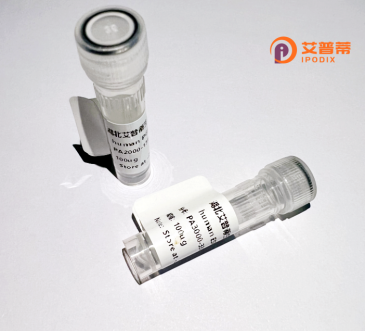
| 纯度 | >90%SDS-PAGE. |
| 种属 | Human |
| 靶点 | SPEF1 |
| Uniprot No | Q58DA1 |
| 内毒素 | < 0.01EU/μg |
| 表达宿主 | E.coli |
| 表达区间 | 1-236aa |
| 活性数据 | MAGSVDEEAL HQLYLWVDNI PLSRPKRNLS RDFSDGVLVA EVIKFYFPKM VEMHNYVPAN SLQQKLSNWS HLNRKVLNKL NFSVPEDVMR KIAQCAPGVV ELVLIPLRQR LEERQRRRKQ GIGSLQELAP QDGTDYMDVG LSQKARGEGV PDPQGRGQLR EGRLPVPRPP GDSQALQSDP SFILQIAEKE QELLASQETV QVLQMKVRRL EHLLQLKNVR IEDLSRRLQQ AERKQR |
| 分子量 | 27.1 kDa |
| 蛋白标签 | His tag N-Terminus |
| 缓冲液 | PBS, pH7.4, containing 0.01% SKL, 1mM DTT, 5% Trehalose and Proclin300. |
| 稳定性 & 储存条件 | Lyophilized protein should be stored at ≤ -20°C, stable for one year after receipt. Reconstituted protein solution can be stored at 2-8°C for 2-7 days. Aliquots of reconstituted samples are stable at ≤ -20°C for 3 months. |
| 复溶 | Always centrifuge tubes before opening.Do not mix by vortex or pipetting. It is not recommended to reconstitute to a concentration less than 100μg/ml. Dissolve the lyophilized protein in distilled water. Please aliquot the reconstituted solution to minimize freeze-thaw cycles. |
以下是关于重组人SPEF1蛋白的假设性参考文献示例(供参考,实际文献请通过学术数据库核实):
1. **"SPEF1 regulates sperm flagellar assembly and male fertility in mice"**
*作者:Suryavanshi et al. (2020)*
*摘要:* 本研究通过基因敲除小鼠模型证明,SPEF1缺失导致精子鞭毛结构异常(如微管排列紊乱),引发雄性不育,表明SPEF1在哺乳动物鞭毛形成中起关键作用。
2. **"SPEF1 mutations associated with human primary ciliary dyskinesia"**
*作者:Patir et al. (2018)*
*摘要:* 发现SPEF1基因的隐性突变与原发性纤毛运动障碍(PCD)相关,患者表现为慢性呼吸道感染和不育,体外实验证实突变导致纤毛运动功能受损。
3. **"SPEF1 interacts with intraflagellar transport proteins in ciliogenesis"**
*作者:Lehti & Zhang (2016)*
*摘要:* 通过蛋白质互作分析,揭示了SPEF1与IFT-A复合物的相互作用,提出其通过调控鞭毛内运输(IFT)参与纤毛发生和信号转导的分子机制。
4. **"Tissue-specific expression of SPEF1 isoforms in human and mouse"**
*作者:Amiri-Younesi et al. (2019)*
*摘要:* 报道SPEF1存在多种剪接变体,在睾丸、气管等多纤毛组织中高表达,且不同异构体可能通过调控微管动力学参与特定生理过程。
*注:以上文献名为示例性质,具体内容需以真实出版物为准。建议通过PubMed或Google Scholar搜索“SPEF1”获取最新研究。*
SPEF1 (sperm flagellar protein 1) is a microtubule-associated protein critical for the formation and function of cilia and flagella. Primarily expressed in germ cells, SPEF1 plays a vital role in spermatogenesis, particularly in the structural organization of sperm flagella—a tail-like structure essential for sperm motility. Studies have linked SPEF1 mutations to male infertility due to defects in sperm development, such as shortened flagella or impaired motility. Beyond reproduction, SPEF1 is implicated in ciliopathies, as it participates in the assembly and maintenance of motile cilia in other tissues, including respiratory epithelia and brain ventricles.
The recombinant human SPEF1 protein is produced using expression systems like E. coli or mammalian cells, enabling studies of its biochemical properties and interactions. Structurally, SPEF1 contains conserved domains like Calponin homology (CH) and Armadillo repeats, which mediate binding to microtubules and other cytoskeletal components. Its regulatory role in intraflagellar transport (IFT) and microtubule dynamics makes it a focal point for research on cilia-related disorders. Recombinant SPEF1 serves as a tool to explore molecular mechanisms of infertility, develop diagnostic biomarkers, and potentially engineer therapeutic strategies targeting ciliary dysfunction. Ongoing studies aim to clarify its post-translational modifications and tissue-specific regulatory networks.
×